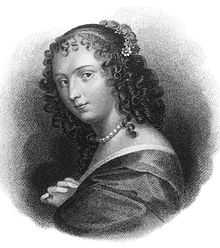Ninon de l'Enclos
| Ninon de Lanclos | |
|---|---|
 Etching by Antoine-Jean-Baptiste Coupé
(1784 -ca. 1852) | |
| Born |
10 November 1620 Paris, France |
| Died |
17 October 1705 (aged 84) Paris, France |
Anne "Ninon" de l'Enclos also spelled Ninon de Lenclos and Ninon de Lanclos (10 November 1620 – 17 October 1705) was a French author, courtesan, freethinker, and patron of the arts.[1]
Early life
Born Anne de Lenclos in Paris, she was nicknamed "Ninon" by her father at an early age. In 1632 her father was exiled from France after a duel, and when her mother died ten years later the unmarried Ninon entered a convent, only to leave the next year.
For the remainder of her life, she was determined to remain unmarried and independent.
Life as a courtesan and author
Returning to Paris, she became a popular figure in the salons, and her own drawing room became a centre for the discussion and consumption of the literary arts. In her early thirties she was responsible for encouraging the young Molière, and when she died she left money for the son of her accountant, a nine-year old named François Marie Arouet, later to become known as Voltaire, so he could buy books.
It was during this period that her life as a courtesan began. Ninon took a succession of notable and wealthy lovers, including the king's cousin the Great Condé, Gaston de Coligny, and François, duc de La Rochefoucauld. These men did not support her, however; she prided herself on her independent income. "Ninon always had crowds of adorers but never more than one lover at a time, and when she tired of the present occupier, she said so frankly and took another. Yet such was the authority of this wanton, that no man dared fall out with his successful rival; he was only too happy to be allowed to visit as a familiar friend," Saint-Simon wrote. This life (not as acceptable in those days as it would become in later years) and her opinions on organized religion caused her some trouble, and she was imprisoned in the Madelonnettes Convent in 1656 at the behest of Anne of Austria, Queen of France and regent for her son Louis XIV. Not long after, however, she was visited by Christina, former queen of Sweden. Impressed, Christina wrote to Cardinal Mazarin on Ninon's behalf and arranged for her release.

In response, as an author she defended the possibility of living a good life in the absence of religion, notably in 1659's La coquette vengée ("The Flirt Avenged"). She was also noted for her wit; among her numerous sayings and quips are "Much more genius is needed to make love than to command armies" and "We should take care to lay in a stock of provisions, but not of pleasures: these should be gathered day by day." A picture of Ninon, under the name of Damo, was sketched in Mlle de Scudéry's Clélie (1654–1660).[2]
Starting in the late 1660s she retired from her courtesan lifestyle and concentrated more on her literary friends – from 1667, she hosted her gatherings at l'hôtel Sagonne, which was considered "the" location of the salon of Ninon de l'Enclos despite other locales in the past. During this time she was a friend of Jean Racine, the great French playwright. Later she would become a close friend with the devout Françoise d'Aubigné, better known as Madame de Maintenon, the lady-in-waiting who would later become the second wife of Louis XIV. Saint-Simon wrote that "The lady did not like her to be mentioned in her presence, but dared not disown her, and wrote cordial letters to her from time to time, to the day of her death". Ninon eventually died at the age of (at least) 82, a very wealthy woman. To the end, she "was convinced that she had no soul, and never abandoned that conviction, not even in advanced old age, not even at the hour of her death." [3]
Influence
Ninon de l'Enclos is a relatively obscure figure in the English-speaking world, but is much better known in France where her name is synonymous with wit and beauty. Saint-Simon noted "Ninon made friends among the great in every walk of life, had wit and intelligence enough to keep them, and, what is more, to keep them friendly with one another."
References
External links
| Wikisource has the text of a 1911 Encyclopædia Britannica article about Ninon de l'Enclos. |
- Ninon de l'Enclos at aelliott.com
- Works by Ninon de l'Enclos at Project Gutenberg
-
 "Ninon de l'Enclos". New International Encyclopedia. 1905.
"Ninon de l'Enclos". New International Encyclopedia. 1905. - Ninon De Lenclos, On Her Last Birthday
"Life, Letters and Epicurean Philosophy of Ninon de L'Enclos: Celebrated Courtesan" https://www.createspace.com/4114809
Further reading
- Lucy Norton, Saint-Simon at Versailles, 1958 p. 100f.
|